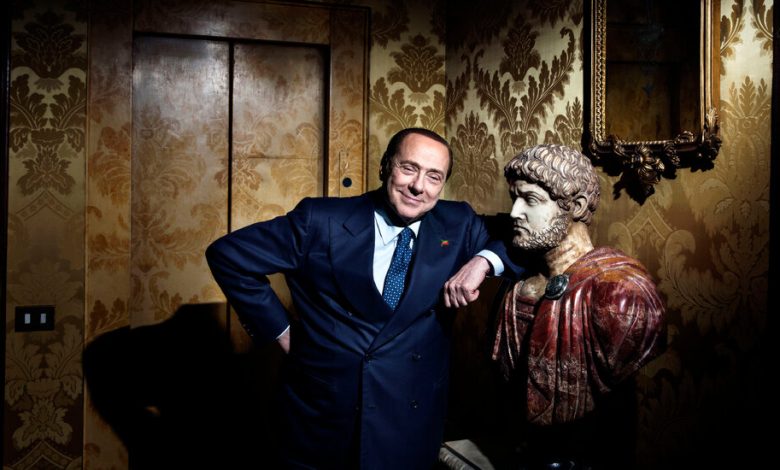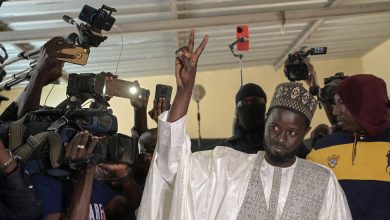The Good. The Bad. The Ugly. Inside Berlusconi’s Art Collection.

As his political fortunes sank, his legal and love life tangled, and his age caught up with him, Silvio Berlusconi stayed up late in his mansion outside Milan calling the hotlines of late-night art shopping television channels.
It didn’t really matter what the oil painting and antiques vendors hawked. Landscapes. Sculptures. Portraits. A fair share of nudes. Night after night, and then year after year, the octogenarian media mogul and former prime minister who wanted to have it all tried to buy it all, amassing an enormous collection of all the mail-order art he could lay his bleary eyes on.
“He had this project to build the largest collection in Italy,” said Giuseppe De Gregorio, a televendor nearNaples who sold thousands of paintings to Mr. Berlusconi. “He didn’t want important paintings. He wanted paintings. It was enough if they were painted with oil on a canvas.”
Now, months after Mr. Berlusconi’s death at age 86, his heirs are figuring out who gets what in his sprawling empire. Despite the understanding among some of Mr. Berlusconi’s dealer friends that his heirs want to unload the artworks, his family said in a statement that they are in no rush to divide up the estimated 25,000 paintings that one expert who saw the collection believes the mogul spent about $20 million on.
The paintings are now stashed in an enormous hangar that critics have characterized as a sort of Raiders of the Lousy Art warehouse. The rumors of fires in the building are “unfounded,” they said. The family declined a request to visit the site.
Mr. Berlusconi had collected some masters over the years, including pieces by Titian and Parmigianino, and the villa he bought in the 1970s in Arcore, outside of Milan, included a respectable art collection. But his recent acquisitions consisted of less notable works.
He emptied Mr. De Gregorio’s store of around 7,000 paintings and other pieces — ranging in cost from 100 euros to 2,000 — mostly buying works on the lower end by living painters. There were street scenes of Paris and Venice, battles and fields of flowers, and lots of Madonnas.
“He loved Napoleon,” Mr. De Gregorio said, recalling that Mr. Berlusconi bought a painting of the French emperor reading a letter, and showed him that he put the work in a room that President Vladimir V. Putin of Russia slept in when he stayed over. The former prime minister did not shy from a colorful palette or an excess of skin. A photo of the warehouse published in the Italian media showed a wall of modern day nudes, like a giant calendar of oil-painted Playboy centerfolds.
“A compendium of different genres,” said Lucas Vianini, a televendor, art historian and subsequently reality television personality, whom Mr. Berlusconi eventually hired as a live-in curator of the collection.
Some of Mr. Berlusconi’s paintings were carefully packaged and personally signed as gifts to friends, political allies, foes and frenemies, including Prime Minister Giorgia Meloni,who reportedly got an image of a mother with child.
But he left behind a vast enough collection of hotel-lobby schlock to attract mockery from critics, defense from family and musings from confidantes about why on earth Mr. Berlusconi went on his Citizen Kane-like shopping spree.
“It is a mystery what goal he had to build this kind of amusement park,” said Vittorio Sgarbi, an art historian, deputy culture minister and a longtime friend, who said that “after the famous Bunga Bunga parties,” Mr. Berlusconi started “this sort of frenzy to collect on television.”
He said he had urged Mr. Berlusconi to rein it in, telling him he should buy a few good works instead. And he said he had warned the former prime minister’s eldest daughter, Marina — who Mr. Sgarbi said was “worried” — that her father needed to be stopped. “There was a real desire to accumulate,” Mr. Sgarbi said. “It’s inexplicable.”
But the art historian gave it a shot, drawing a connection between Mr. Berlusconi’s seeming desire to live forever and his collecting mania. As long as he could keep purchasing, Mr. Sgarbi suggested, Mr. Berlusconi could imagine he could keep on living.
“I don’t know if he ever thought he would die, this accumulation was like buying up everything while he could, a sort of horror vacui,” he said, using the Latin for “fear of an empty space,” often used in art. “‘I don’t have much time,’” he added, imagining what he supposed was Mr. Berlusconi’s thinking, “‘so I’m taking whatever I can, without selecting.’”
The buying filled Mr. Berlusconi, he said, with the desire to become “the greatest collector in the world, but it was a problem, and his collection was a sort of great illusion.”
Mr. De Gregorio said Mr. Berlusconi was obsessed by and commissioned multiple versions of the mythical allegory of “Selene and Endymion,” the story of a handsome shepherd, kept forever young in an eternal sleep during which the smitten moon goddess had her way with him. “He loved,” Mr. De Gregorio said, that “the shepherd was immortal.”
To hear it from the televendors, the story of Mr. Berlusconi’s collecting was less that of an old man trying to stave off mortality with stuff, than a lover of life who wanted to fill his villas, gardens and eventually a warehouse, with the paintings that made him happy and showed who he was.
“Very ambitious and somewhat extreme,” Mr. Vianini said of the collection, which he has also called a “leitmotif of his existence.”
Mr. Berlusconi first called in to Mr. De Gregorio’s late night shopping hotline in 2019. The vendor recalled that he hung up on him three times. “I thought it was a joke,” he said.
When his identity was verified, “the entire studio froze,” he recounted. Mr. Berlusconi bought a bunch of paintings depicting Canadian mountains in the snow. “And from there began an adventure that lasted three years,” Mr. De Gregorio said.
Mr. De Gregorio hand-delivered the paintings, which Mr. Berlusconi told him were “even more beautiful in real life.”
He went to see Mr. Berlusconi often, getting a tour of the more refined picture gallery inside the Arcore mansion. Often, Marta Fascina, Mr. Berlusconi’s girlfriend and 50 years his junior,watched them unpack the goods. (Mr. Sgarbi, the art historian, said she supported her boyfriend’s hobby.) Mr. De Gregorio would spend the day with Mr. Berlusconi, he said, talking pictures and the art world, and eating lunch and dinner. “He also liked the company, ” the televendor said.
Some televendors, including Alessandro Orlando, a veteran of the industry, said Mr. Berlusconi selected his paintings and antiques “like a surgeon.” He conducted at least 3,000 operations, spending about 2.5 million euros, over a couple years, Mr. Orlando said, buying what he offered.
Mr. Orlando, too, spent time in Arcore. More than once, he said, Mr. Berlusconi told him, ‘Alessandro, come, I’ll show you the Bunga Bunga room.’” He said he declined.
He welcomed Mr. Berlusconi to his gallery in Brescia a half dozen times, and once received an advisory call from the dieting billionaire’s doctor not to feed him. Mr. Berlusconi took a seat of honor as the gallerist slid the canvases through a display case, like a giant slide show. Mr. Berlusconi picked out the ones he liked as they went by.
“He loved a collection of Russian artists I had and wanted to give them as a gift to Putin,” Mr. Orlando said. In the end, Mr. Berlusconi decided to keep them for himself. Those works didn’t cost much, but for Mr. Berlusconi money didn’t seem to matter. “A painting could cost 500 euros or 150,000 euros,” Mr. Orlando said. “There was no difference.”
Mr. Berlusconi became especially fond of one of Mr. Orlando’s salesmen, Mr. Vianini, putting him — and eventually his sister — up in the luxurious Villa Gernetto, close to Arcore. From there, wearing a suit in a rococo room, Mr. Vianini conducted “The President’s Collection,” a showcase produced by Mr. Berlusconi’s Mediaset channel, of paintings he called of “great value.”
At one point the collecting seemed to get out of hand even for Mr. Berlusconi. Once word had gotten out that the former prime minister was buying in bulk, art vendors, mostly from Naples, started sending trucks up to Arcore, and Mr. Orlando recalled seeing workers unload hundreds of paintings, including vibrant nudes, in the hope of a sale.
“‘Silvio, how much stuff have you bought?’” Mr. Orlando recalled asking Mr. Berlusconi.
Late in Mr. Berlusconi’s life, in his final run at politics, his paintings became presents to buy favor in a campaign for president of Italy that went nowhere. As he hid an ultimately fatal illness, the great collector “married” Ms. Fascina in a faux ceremony and settled for a peripheral role as a cantankerous junior partner in a new government.
Mr. De Gregorio attended his funeral in June and recalled a man who loved life and the pleasures that made it worth living, including buying an OK oil off the television after midnight.
“He had his own dedicated phone line,” said Mr. De Gregorio, adding, “he bought a lot.”





